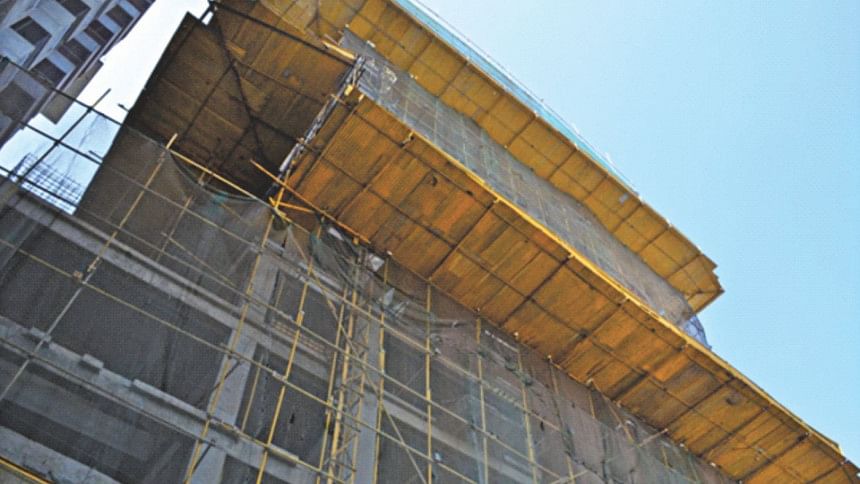How to ensure safety on a construction site

Like any other rapidly developing urban city of the world, Dhaka was built by thousands of trained and untrained construction workers. Unfortunately, due to a lack of supervision or monitoring by a regulatory agency, the safety and welfare of these construction workers are often not ensured, because the safety measures available are dependent solely on the policy of the company.
A 2010 report by the Bangladesh Occupational Safety, Health and Environment Foundation (OSHE) revealed that in a year 110 workers had died in the construction sector of Bangladesh. What is even more alarming is that this statistic was based on what was reported in 15 different newspapers, so in reality the number of deaths may actually be higher from unreported incidents.
The construction industry as a whole must take remedial action, and pledge to improve the safety conditions on their sites.
There are three basic safety measures each construction company can take to improve the safety conditions on their sites:
1) Enclosing the construction site from the surrounding environment:
For any construction site, it is imperative to enclose it from the surrounding environment, so as to not disturb the neighbours and to ensure that passers-by are not subjected to hazard from falling dust or debris from the construction. This can be easily achieved by erecting a boundary fence and adding scaffolding with safety net and canopy.
Having scaffolding with safety net around the under-construction building will reduce the risk of falling debris and the amount of dust blowing out to the surroundings. Adding canopies at various levels of the building will reduce the risk of falling objects even further. Pedestrian canopies with safety nets are essential to protect passers-by from falling debris.
2) Housekeeping on construction site for cleanliness and safety: There are many aspects regarding housekeeping and these can be broken down into four major categories.
Housekeeping: The site has to be kept in a clean and orderly fashion to reduce tripping and slipping hazards. It is important to clean the sewers and drains periodically to avoid water clogging on sites, ensure proper lighting, put up proper signage for electrical, fire and other hazards and make sure that all firefighting tools are needed to put in designated places and in proper working condition.
* Disposal of construction trash: Without an organised system of cleaning and disposal, construction scrap and debris can easily pile up on a site, which can later lead to tripping and other hazards.
* Falling hazards: Guard rails must be erected at all floor openings, gangways and elevated work stations as a precaution against falling hazards.
* Electrical Hazards: A lot of temporary electrical work is often done on construction sites. Running these temporary wires through flexible piping is a cost-effective way of providing insulation.
3) Labour welfare:
Despite certain obligations being mandated by the Bangladesh National Building Code (BNBC) and the Bangladesh Labour Act (BLA), the welfare of the construction workers is often neglected. Without a properly trained and healthy labour force, construction safety can never be ensured. The features that must be put in place include:
* Personal protective equipment (PPE): The construction company or contractor must provide all the PPE that is required to keep the construction workers safe during all phases of construction.
* Safety and emergency training: The construction workers must be given safety training, so that they know how to properly use the safety equipment. Different stages of construction require different PPE usage, so the workers must also know the appropriate PPE for each type of construction work, as well as if any additional precaution is required for any step.
* Other welfare facilities: The BNBC contains provisions that require construction sites to have a clearly labeled and conveniently located source of drinking water, as well as clean and well maintained sanitary and washing facilities. In addition to this, the BLA stresses the need for suitable rest rooms and lunch rooms to be provided for the workers. These requirements are very basic and should not be too difficult or costly to provide.
Statistics show that safety is a neglected aspect of construction in Bangladesh, and that reform is needed in the construction industry to promote labour safety and welfare. While there are a countless number of safety measures a company can take, there are basic measures and these measures can be undertaken economically and efficiently with a little planning. Once the basic level of safety is achieved, construction companies should decide on a monitoring system through which they can ensure that the safety policies they have undertaken are upheld.
Companies should always keep in mind that improving safety on sites requires certain financial investments, and these investments will return exponential rewards in terms of a healthy, motivated, efficient and dedicated labour force.
The author is a director (engineering) at Sheltech and a civil engineer with a PhD from the University of Texas, Austin, the USA.

 For all latest news, follow The Daily Star's Google News channel.
For all latest news, follow The Daily Star's Google News channel. 



Comments